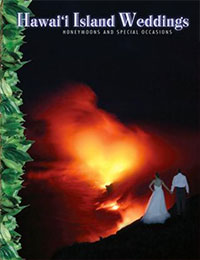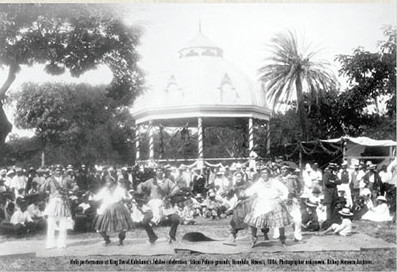Wedding Lei
 The lei, that iconic symbol of our islands, is actually found in many cultures. Swiss maidens, Hindu priests, Thai brides and grooms, the flower children of the 60s, and Neanderthal of 60,000 years ago all have been noted for their flower garlands. Hawaiians, however, may have developed the concept into a more diverse cultural role than many others. For traditional Hawaiians, and those who love Hawai‘i, lei grace every ceremony, celebration, and commemoration. Lei are tangible and intangible. They are form and metaphor. They are imbued with historical, cultural, and spiritual importance.
The lei, that iconic symbol of our islands, is actually found in many cultures. Swiss maidens, Hindu priests, Thai brides and grooms, the flower children of the 60s, and Neanderthal of 60,000 years ago all have been noted for their flower garlands. Hawaiians, however, may have developed the concept into a more diverse cultural role than many others. For traditional Hawaiians, and those who love Hawai‘i, lei grace every ceremony, celebration, and commemoration. Lei are tangible and intangible. They are form and metaphor. They are imbued with historical, cultural, and spiritual importance.
In a mo‘olelo, a story, that I learned as a child, the art of the lei was brought to our islands by Kuku‘ena, a seeress, a sister of Pele, and goddess of lei making. Before leaving her southern homeland, she carefully tucked the seeds of her beloved lei plants into the rolls of her pā‘ū, her beautifully crafted skirt. Arriving in her new home, she shook out her pā‘ū, scattering the seeds to the winds, which carried them throughout the islands so they would thrive and benefit humanity. It is interesting to note that lei are used in healing ceremonies, and many of the traditional plants used in lei making are also used in lā‘au lapa‘au, herbal medicine.
Probably most associated with all things romantic is the lei maile. Its heady scent evokes images of lovers wooing each other in a tropical bower. Indeed, throughout Hawaiian history, myth, and legend, it is associated with courtship and romance.

Often, both the bride and groom will wear maile, either alone or with floral lei kui (strung lei) intertwined. Sometimes only the bride will add a floral lei. Sometimes the bride will wear a fragrant floral lei intertwined with the maile, and the groom will wear ‘ilima intertwined with his lei maile. There are no hard and fast rules. Just as the ceremony should reflect the individuality of the bride and groom, and their hopes and dreams together, the lei chosen to adorn them should do the same.
That being said, it is nice when the lei and the attire of the wedding party compliment each other. In general, lei such as white or yellow ginger, gardenia, carnation, crown flower, loke, pīkake, and ‘ilima, would be among the more formal flower lei, roughly equivalent to wearing pearls. The momi ke‘oke‘o or lāiki ke‘oke‘o (small white shells from Ni‘ihau), and lei hulu kāmoe or poepoe (traditional styles of feather lei) would be roughly equivalent to wearing diamonds.
These floral lei provide an especially lovely effect in long strands on a traditionally cut holokū. With a more modern gown, choker length would be elegant. The final decision should be made based on the actual gown and taste of the bride. Of course, if the bride is blessed with an heirloom lei hulu or lei lāiki ke‘oke‘o, she might wish to choose the gown to suit the lei.
At the other end of the spectrum are the brightly colored, lushly petaled lei such as plumeria, Thai orchid, and lei of mixed flowers and colors. In general, the brighter the colors and more flamboyant the petals, the less formal the lei. These lei are ideal with informal wedding dresses, sarongs, and weddings with a bright, festive theme.
The lei lā‘ī, or ti leaf lei, is always appropriate, and can be made in any number of styles, from a simple twist in the hilo style to ornate ropes of baby roses fashioned from the leaves, themselves.
Some people like to make the lei an integral part of the wedding ceremony. Borrowing from the Catholic tradition of our Latin community, and blending with Hawaiian, the lazo, or wedding rosary, is sometimes replaced with a lei of maile or fragrant small white blossoms such as pīkake.
Other couples choose to exchange lei in lieu of, or in addition to, rings or other symbolic gifts. Often, the lei are open style, such as maile, and then tied closed at the end of the ceremony to symbolize their unity, wholeness, and unending devotion.
Lei for the Wedding Party
Generally, if the bride and groom wear lei, so does the rest of the wedding party, though their lei will be less elaborate and either of different materials, or in different styles, from those of the bride and groom.
Lana Haasenritter of Ah Lan’s Lei Stand, says, “If they are from here, normally the bride or her mother comes and orders her lei. Sometimes it’s the in-laws. The most popular is pīkake and maile. It’s nice if it’s a 3-strand because pīkake is small.” Flowers are dependent on the weather and other conditions, so sometimes crown flower will be substituted for pīkake, if they are not available.
Fathers and grandfathers (or those who fill those roles) of the couple are often presented with lei maile or cigar flower lei. The maile can be worn alone, or wrapped around ‘ilima. It would not be wrapped around a cigar flower lei, because it would hide the intricate designs so carefully stitched with the tiny flowers. Cigar flowers come in a range of salmon, orange to red, and rust colors, and the designs can be fine or bold, so they can be coordinated to look well against the man’s shirt or coat.
Mothers and grandmothers (or those who fill those roles) often are given mauna loa style orchid lei, carnation lei, or Micronesian style ginger lei. It’s a good idea to find out what they plan to wear and coordinate the lei with them. The carnation lei can be tinted to match or contrast with their attire.
When a lei is worn, there is no need for a corsage or boutonniere. If a woman does receive a corsage when she plans to wear a lei, if it goes with her hairstyle, it can be lovely in her hair. If not, it can be pinned to a scarf or her wrap.
While there are few “rules” regarding lei in weddings, since about World War II, certain customs have come into use. As a lei is such a special gift, many people over the years probably gave them with a kiss, and it was not until World War II that this became a “custom of Hawai‘i.” The story goes that some USO entertainers were teasing each other, and encouraging one of their performers to give a kiss to a good looking young serviceman. Looking for an excuse, she gave him her lei, with a kiss, saying, “This is an ancient custom of Hawai‘i.” The new “ancient custom” caught on, and has become part of the popular culture. So, when giving a lei, many people place it over the recipient’s head and give a kiss.
If everyone is comfortable with kissing each other, this is fine. Sometimes the wedding is the first meeting of many members of the bride’s and groom’s families. In that case, they may not be comfortable kissing.
An older tradition for giving the lei is to hold it in both hands just above the heart, and offer it to the recipient. The recipient will then take it and put it on. This tradition avoids placing one’s hands over another’s head, which is considered disrespectful by many traditional Hawaiian people.
For all fresh lei, there are a few things to remember:
When choosing:
Make sure none of the wedding party are allergic or sensitive to the flowers. Make sure the lei will not stain the garments you are wearing.
When transporting/storing:
Keep them cool, not cold. Too cold can brown the blossoms. Allow the lei to breathe before putting them on. A lei fresh out of the florist bag is cold, wet, uncomfortable to wear, and can stain clothing.
To Save the Wedding Lei:
Many lei, such as maile, dry beautifully and keep their fragrance for a long time. They can be hung over a wedding photo, the bride and groom’s bed, or the door of their home. It can also be placed in a desiccant and then once preserved, placed in a sealed container.
When it’s time to dispose of the lei:
Eventually, though, all floral lei will become too fragile to keep. No lei should be casually thrown away. They should be returned to the land. Some people hang their lei in a tree in a special place, others have a kuahu (alter) or perhaps some kind of mound. Others take the lei apart and cast the crumbling petals into the wind. Whatever way preserves the memory of the meaning of that lei is the best.
The most important thing to remember about lei is that they are to be made, given, and received with aloha.
